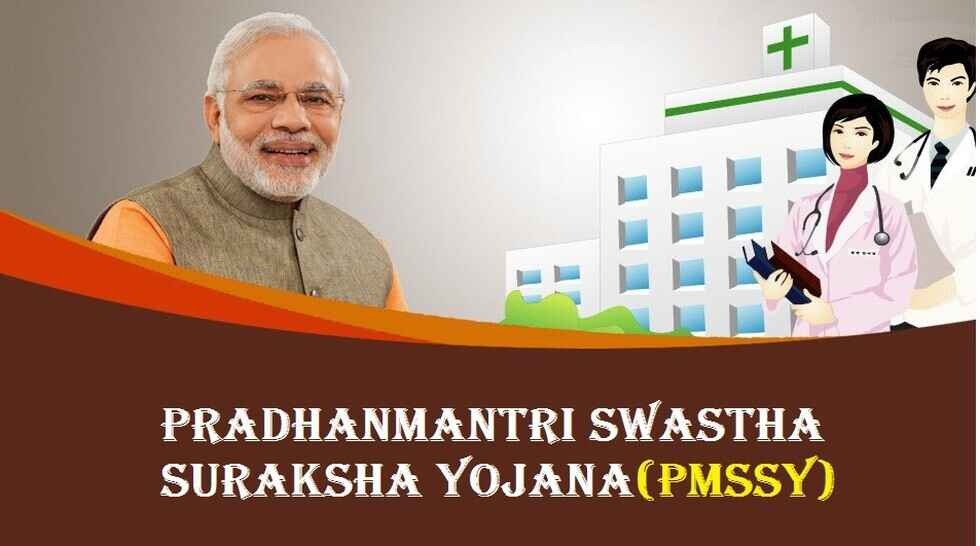In a massive push to make quality healthcare accessible to the masses, the Government of India launched the Pradhan Mantri Swasthya Suraksha Yojana (PMSSY) in March 2006—a scheme aimed at enhancing affordable medical facilities and augmenting capacity for medical education across the country.
Being implemented in three phases, PMSSY involves setting up of new AIIMS-like institutes as well as upgradation of existing government medical colleges spread across underserved states.
With a total budgetary allocation of over ₹14,000 crores, the scheme has facilitated significant addition to India’s healthcare infrastructure—with 15,000 additional beds, 3,000 more doctors and 6,000 new nurses. This blog post explores PMSSY in detail – tracing its objectives, implementation status, coverage, budget and impact.
What Is Pradhan Mantri Swasthya Suraksha Yojana (PMSSY)?
Pradhan Mantri Swasthya Suraksha Yojana (PMSSY) is a central scheme launched in March 2006 with the aim to correct imbalances in the availability of tertiary healthcare facilities across different parts of India and to enhance capacity for quality medical education in under-served states.
Specifically, the objectives of PMSSY are:
- Set up new AIIMS-like institutions in various states to expand access to superspecialty care
- Upgrade existing government medical colleges and hospitals into well-equipped tertiary care centers
- Augment capacity for quality medical education and training of doctors and para-medics
- Correct intra-regional and inter-regional imbalances in healthcare infrastructure
Under this scheme, greenfield AIIMS-like institutes are being constructed while extensive upgrades are being made to existing institutes in terms of addition of super speciality blocks, modern equipment, enhanced Human resource etc.
The scheme is being implemented in 3 phases so far, with 8 AIIMS and about 22 upgraded institutes being supported under it across 15 underserved states. Over 15,000 additional beds, 3000 more doctors and 6000 extra nurses are being added through PMSSY institutes across India.
With a total budgetary support of over 14,000 crore, the scheme plays a seminal role in strengthening healthcare capacity and widening quality tertiary care coverage for the masses.

Implementation Of PMSSY
PMSSY is being implemented in three phases with the following key objectives:
Phase I (Approved in March 2006)
- Set up six AIIMS-like medical institutes in Bihar, Chhattisgarh, Madhya Pradesh, Odisha, Rajasthan and Uttarakhand
- Upgrade 13 existing government medical colleges across 10 states
Phase II
- Establish two more AIIMS-like institutes in West Bengal and Uttar Pradesh
- Further upgrade six more medical colleges in Punjab, HP, Tamil Nadu, Maharashtra and UP
Phase III
- Upgrade seven more medical colleges in UP, MP, Bihar, Kerala and Karnataka
The scheme focuses on expanding tertiary healthcare capacity by setting up new superspeciality hospitals and upgrading existing institutions. Under phase I, six new AIIMS institutes are being constructed at a cost of ₹840 crores each to provide speciality care in 42 disciplines.
The upgradation of existing colleges under PMSSY will enable addition of super speciality blocks, new equipment, additional human resource etc. As of 2022, 22 institutes are being supported under PMSSY across 15 states.
Impact Of PMSSY
- Additional 15,000 beds, 3,000 doctors and 6,000 nurses added through PMSSY
- Special focus on correcting regional imbalance in healthcare services
- Augmenting capacity for quality medical education and training
With a substantial budgetary allocation of over ₹14,000 crores, PMSSY is playing a seminal role in achieving universal healthcare coverage in India by strengthening healthcare infrastructure across underserved regions.
The scheme has been successful in addressing gaps, especially in tier-2/3 cities, by setting up quality tertiary care hospitals and medical institutes.
Selection Criteria For States
The states chosen to set up new AIIMS or upgrade institutes under Pradhan Mantri Swasthya Suraksha Yojana have been selected based on certain well-defined criteria:
Healthcare Gaps: States that reflect poorer health outcomes, infrastructure deficits or shortage of doctors have been prioritized. Some of the parameters considered are:
- High population-to-bed ratio
- Low doctor-population proportion
- High infant mortality, maternal mortality rates
- Low life expectancy
- High prevalence of communicable diseases
Socio-economic indicators: States lagging on human development parameters and economic prosperity are given preference:
- Low per capita income
- High poverty rate
- Low literacy levels
- Poor performance on overall human development index
Regional imbalance: States from underserved regions such as north-east, central or eastern parts have got higher representation to correct territorial imbalance.
The methodology relies on composite scoring across these metrics to ensure the maximal health impact through optimal targeting of resources under PMSSY.
The index-based approach objectively captures healthcare priorities based on level of need. Periodic reviews also enable dynamic state selection aligning with evolving needs.
Fund Allocation Process
Here are the key aspects of the fund allocation process under Pradhan Mantri Swasthya Suraksha Yojana (PMSSY):
- Fund Flow: The funds for PMSSY are allocated upfront in the union budget and no separate supplementary grants are required.
- Direct Allocation: Unlike other schemes, the fund allocation is made directly to implementing agencies like CPWD, HLL Infra Tech Services Limited and Ministry of Health and Family Welfare from the budget, bypassing state treasuries.
- Escrow Accounts: In some cases, escrow accounts have been opened for direct fund transfer to executing agencies without going through civil ministries or departments.
- Release Cycles: Funds are released on a quarterly basis based on institute budgetary demands and utilization certificates against allocated funds are mandate before next release.
- Monitoring: Scheme steering group and monitoring unit track fund utilization, institute work progress and quality parameters through monthly reports and on-site inspections.
By provisioning direct allocation with robust monitoring, the fund flow efficiency is enhanced ensuring availability, reducing idlefunds and implementation delays through minimal bureaucratic hurdles.
Progress Tracking Of Pradhan Mantri Swasthya Suraksha Yojana (PMSSY)
- Quarterly Progress Reports: All institutes under PMSSY have to mandatorily submit detailed progress reports every quarter on set formats covering financial and physical progress.
- On-Site Inspections: Regular on-site inspections are conducted by central and state level monitoring teams to review actual work vis-a-vis progress reports.
- Review Meetings: The PMSSY steering group chaired by the Health Secretary conducts periodic review meetings attended by project executing agencies to discuss impediments impacting timelines.
- Audit Checks: The progress made by the institutions is subject to routine audit examinations by Accountant General’s special audit teams.
- Public Dashboard: Progress reports and timelines of ongoing institute projects are available in the public domain on the scheme website.
Conclusion
We hope that through the Pradhan Mantri Swasthya Suraksha Yojana (PMSSY), quality healthcare will become more accessible across India.
The scheme is investing in new AIIMS-type institutes and upgrading existing government hospitals and colleges. The aim is to improve healthcare infrastructure in underserved areas.
So far, PMSSY is helping set up 22 institutes which will add 15,000 more hospital beds and 9,000 doctors and nurses. New facilities are coming up in over 15 states, targeting areas with less access to good healthcare.
PMSSY institutes are reporting rising number of patients. This shows the scheme is successfully taking advanced medical care to remote parts of India.
Going forward, we hope PMSSY expands further. More districts with poor healthcare access can benefit if new facilities are set up and existing ones upgraded. The Centre and States need to join hands to enable this. More people can then avail quality and affordable treatment near their homes.
So PMSSY has the potential to make healthcare truly accessible pan-India. Investing in healthcare infrastructure is key for this vision to become a reality.


